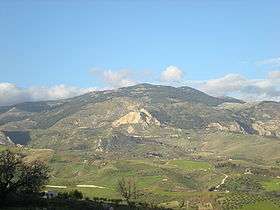Province of Agrigento
| Province of Agrigento | |
|---|---|
| Province | |
|
Monte delle Rose (IT), Mountain of Roses (EN), Muntagna de Rosi (Sicilian), Mali i Trëndafilët (Arbëreshe) | |
 Map highlighting the location of the province of Agrigento in Italy | |
| Coordinates: 37°19′N 13°35′E / 37.317°N 13.583°ECoordinates: 37°19′N 13°35′E / 37.317°N 13.583°E | |
| Country |
|
| Region | Sicily |
| Capital(s) | Agrigento |
| Comuni | 43 |
| Government | |
| • President | Eugenio D'Orsi |
| Area | |
| • Total | 3,042 km2 (1,175 sq mi) |
| Population (30 June 2009) | |
| • Total | 454,370 |
| • Density | 150/km2 (390/sq mi) |
| Time zone | CET (UTC+1) |
| • Summer (DST) | CEST (UTC+2) |
| Postal code | 92100, 92010-92029 |
| Telephone prefix | 0922, 0925 |
| Vehicle registration | AG |
| ISTAT | 083 |
| Website |
www |
The Province of Agrigento (Italian: Provincia di Agrigento; Sicilian: Pruvincia di Girgenti) is a province in the autonomous island region of Sicily in Italy, situated on its south-western coast. It has an area of 3,041.90 square kilometres (1,174.48 sq mi), and a total population of 474,493.[1] There are 43 comunes (Italian: comuni) in the province.[2]
History and location
It is surrounded by Province of Palermo in the north, Trapani in the west, Mediterranean Sea in the south and Caltanissetta in the east. Gela inhabitants founded the province in 6th century B.C. as Akragas. The province was destroyed by the Carthage in 406 B.C. but was later ruled by the Romans, Goths, Byzantines and Arabs. The Arabs rebuilt several parts of the province. Several ancient Doric temples were constructed during the 6th and 5th century B.C. for the purpose of worshiping Hercules, Olympian Jupiter, Juno, Castor, Pollux and Demeter. They are located in the Valley of Temples (Italian: Valle dei Templi).[3] The ancient temples and other architectural structures were built using the stones of the hills near Capo San Marco.[4]
Places
The most important cities are Agrigento (the capital), Sciacca, Canicattì, Favara, Licata, Porto Empedocle. Agrigento is the birthplace of the noted writer Luigi Pirandello and the philosopher Empedocles.[2] According to the government records the number of unemployed people is about 17% of the total labour force.[1] The province faces the Channel of Sicily in the south and is known for its beaches. The beaches of Torre Salsa have been designated as natural reserves and are protected due to their environmental importance.[4]
Wine production
The province is well known for its vineyards and wines. The total areas covered by vineyards in 1984 was almost triple to that in 1949.[5] During this period Marsala based wine merchants used the grapes produced in the province to produce Marsala wine. In 1984 the local government passed a law which regulated this practice.[6] Around three-quarters of the Sicilian land devoted to growing Fiano grapes is in the province.[7] Some of the important municipalities known for their vineyards include Sambuca di Sicilia, Menfi and Santa Margherita di Belice.[8]
Transportation
The road network in the province comprises 540 km. of street roads, 1,000 km. of provincial roads, 260 km. of communal roads and 56 km. of regional roads. 55% of the total rail network is suitable for electric trains.[1]
References
| Wikivoyage has a travel guide for Agrigento (province). |
- 1 2 3 "Some data about the Province of Agrigento". Sicilia.it. Retrieved 18 September 2014.
- 1 2 "Provincia di Agrigento". Agrigento-Sicilia. Retrieved 18 September 2014.
- ↑ "The province of Agrigento and its cities". Sicilybella. Retrieved 18 September 2014.
- 1 2 Touring Club of Italy (2005). Authentic Sicily. Touring Editore. p. 120. ISBN 978-88-365-3403-6.
- ↑ Nesto & Savino 2013, p. 198.
- ↑ Nesto & Savino 2013, p. 170.
- ↑ Nesto & Savino 2013, p. 95.
- ↑ Touring Club of Italy (2002). The Italian Food Guide: The Ultimate Guide to the Regional Foods of Italy. Touring Editore. p. 567. ISBN 978-88-365-2538-6.
Bibliography
- Nesto, Bill; Savino, Frances Di (2013). The World of Sicilian Wine. University of California Press. ISBN 978-0-520-95507-3.

